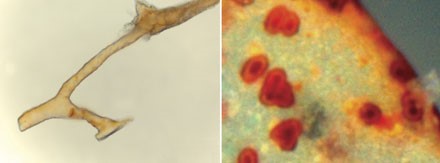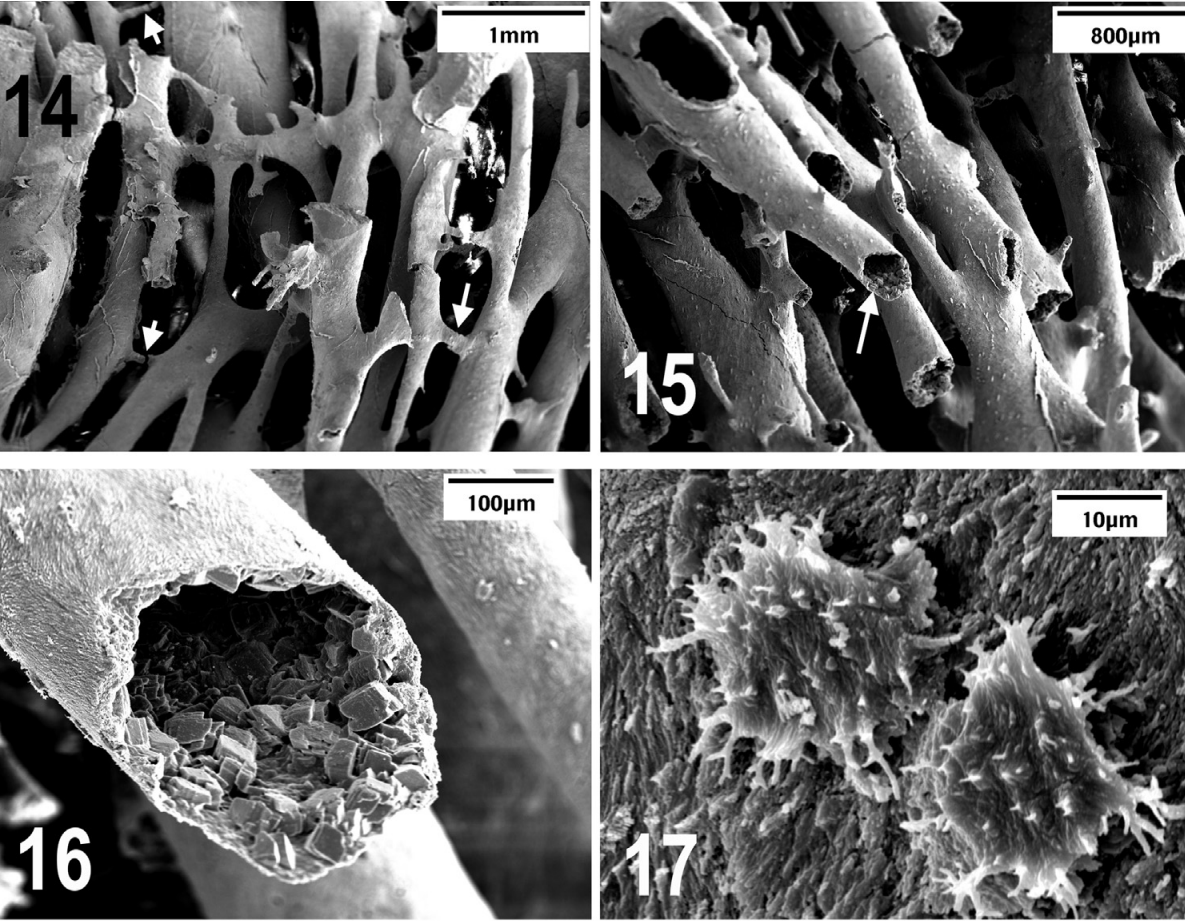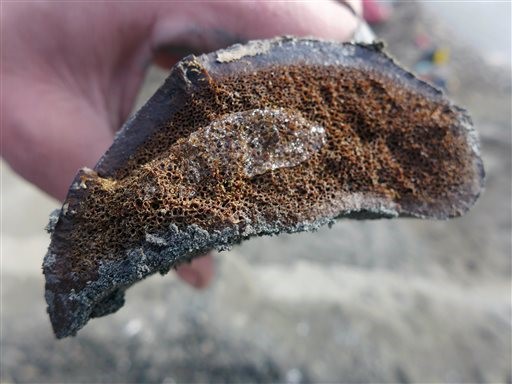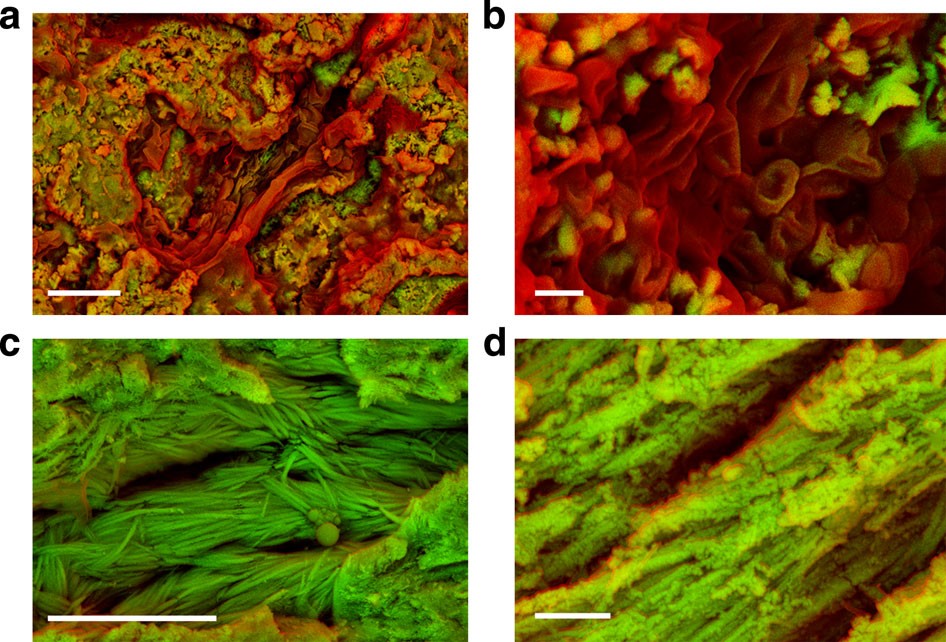The Bible is clear that humans were alive at the same time as dinosaurs. We were created to take dominion over all that God had just created, and Adam named every kind of animal after they were created. Genesis 1 says God created the great beasts, and dinosaurs qualify. Behemoth, likely a sauropod, lived with Job (see Job 40:15). There was no “dinosaur era” millions of years before humans existed. Dinosaur soft tissue and original organics including proteins provide strong evidence for the recency of dinosaurs as well as for the way in which the vast majority of them perished. Further, many dinosaurs have design features that give clues that the pre-flood world was much different than the world today. Fewer than 1,000 species have been identified based on fossils, with fewer than 80 inter-fertile kinds. It would have been feasible for Noah to load juveniles on the Ark. Next let’s review one of the leading evidences that support the recent demise of the dinosaurs: dinosaur soft tissue.
Dinosaur Soft Tissue
Over 50 scientific, peer-reviewed journal articles describe 14 bio-organic materials in dinosaur bones that simply should not exist if the dinosaurs died out 65 million years ago. Many of these, like collagen, have studied decay rates that establish maximum shelf-lives of between 10,000 and 100,000 (some studies) and 300,000 to 900,000 years (other studies). Both are far, far shorter than 65 million years.
Because the “expiration date” for these 14 bio-organic materials is well before 65 million years, they must be just thousands of years old. The science of protein decay fits the Bible’s timeline of dinosaurs recently buried in Noah’s Flood much better than it does evolutionary long ages.
For readers who would like to dive deeper into this line of research, we recommend the Spring 2015 issue of the Creation Research Society Quarterly Journal,[i] which includes a technical review of what’s covered in summary form below.
Fresh Dinosaur Biomaterial #1: Blood Vessels

Blood vessels transport blood throughout the body. They include the tiny capillaries, through which water and chemicals pass between blood and the tissue. Bones include capillaries and larger vessels. Small, pancake-shaped cells loaded with long-lasting collagen protein comprise blood vessels.
The blood vessels shown in Figure 1 were discovered when Dr. Mary Schweitzer’s team was attempting to move a gigantic Tyrannosaurus rex fossil by helicopter that turned out to be too heavy. They were forced to break apart the leg bone. When looking at the inside of the leg bone at the lab, they discovered that the inside of the bone was partially hollow (not mineralized), revealing the soft tissue shown in Figure 1 that was extracted after treatments to remove the minerals.[ii]
The tissues that are shown on the left of Figure 1 show that it is flexible and resilient. When stretched, it returned to its original shape. The middle photo shows the bone after it was air dried. The photo at right shows regions of bone showing fibrous tissue, not normally seen in fossil bone.
Since this publication in 2005, blood vessels from several other dinosaurs and other extinct reptiles have been described and published in numerous leading scientific journals, including the Annals of Anatomy, Science (the leading journal of the American Association for the Advancement of Science), Public Library of Sciences ONE, and the Proceedings from the Royal Society B, which focuses on the biological sciences.[iv]
Fresh Dinosaur Biomaterial #2: Red Blood Cells
Red blood cells carry oxygen and collect carbon dioxide using hemoglobin protein—also found in dinosaur and other fossils. Dr. Mary Schweitzer was one of the first to discover and publish the discovery of red blood cells, which she shares in her own words: “The lab filled with murmurs of amazement, for I had focused on something inside the vessels that none of us had ever noticed before: tiny round objects, translucent red with a dark center. Then a colleague took one look at them and shouted, ‘You’ve got red blood cells. You’ve got red blood cells!”’[v]

These two photos in Figure 2 are from a 2005 discovery from Dr. Schweitzer that clearly show blood vessels from a T. rex bone (left) and red blood cells (right). How could these cells last for 65 million years? At least five peer-reviewed scientific journals have published accounts of red blood cells in dinosaur and other fossil bones.[vi]
Regarding this discovery, Dr. Schweitzer remarked, “If you take a blood sample, and you stick it on a shelf, you have nothing recognizable in about a week. So why would there be anything left in dinosaurs?”[vii] That’s certainly a good question, and one that has an easier answer if dinosaurs are only thousands of years old!
After this discovery, Dr. Schweitzer ran into challenges when trying to publish her work in the scientific literature. Dr. Schweitzer remarks, “I had one reviewer tell me that he didn’t care what the data said, he knew that what I was finding wasn’t possible.” Dr. Schweitzer wrote him back and asked, “Well, what type of data would convince you.” The reviewer replied, “None.”
Fresh Dinosaur Biomaterial #3: Hemoglobin
Hemoglobin protein contains iron and transports oxygen in red blood cells of most vertebrates. Some invertebrates, including certain insects and some worms, also use hemoglobin. In vertebrates, this amazing protein picks up oxygen from lungs or gills and carries it to the rest of the body’s cells. There, oxygen fuels aerobic respiration by which cells produce energy.
Scientific studies have reported “striking evidence for the presence of hemoglobin derived peptides in the (T-rex) bone extract”[viii] and several other dinosaur “era” bones.[ix]
Fresh Dinosaur Biomaterial #4: Bone Cells (Osteocytes)
Secular scientists have described dinosaur proteins like hemoglobin, even though no experimental evidence supports the possibility that they can last for even a million years. But dinosaur bones hold more than just individual proteins. They sometimes retain whole cells and tissue remnants. An osteocyte is a bone cell that can live as long as the organism itself. Osteocytes constantly rebuild bones and regulate bone mass. Figure 3 shows highly magnified blood vessels, blood products, and osteocytes that were found on the inside of a brow horn of a Triceratops.

Figure 3 shows blood vessels linked together (white arrows in frame 14). Frame 15 shows possible blood products lining the inner wall of a hardened vessel (white arrow). Frame 16 is enlarged from frame 15 and shows crystallized nature of possible blood products lining inner wall of hardened vessel. Frame 17 shows two large oblate osteocytes lying on fibrillar bone matrix.
At least four scientific studies have established osteocytes in dinosaur bones. One study even found nucleic acid signatures consistent with ancient DNA right where the nucleus would have been in dinosaur osteocytes.[xi]
Fresh Dinosaur Biomaterial #5: Ovalbumin (Proteins)
Another protein found in fossils that microbes don’t make is called ovalbumin. It makes up 60–65% of the total protein in egg whites. Ovalbumin has been found in exceptionally preserved sauropod eggs discovered in Patagonia, Argentina, a dig site that included skeletal remains and soft tissues of embryonic titanosaurid dinosaurs. These findings were reported in a peer-reviewed scientific journal.[xii]
Fresh Dinosaur Biomaterial #6: Chitin
Chitin is a biochemical found in squid beaks and pens, arthropod exoskeletons, and certain fungi. If chitin was meant to last for millions of years, then it might have filled Earth’s surface as dead insects, krill, and fungi left their remains over eons. Chitin is tough, but no known experiment supplies any reason to so much as suspect that it could last a million years, let alone hundreds of millions, as at least two scientific studies report finding in fossils.[xiii] Our Creator equipped many microbes with unique enzymes that digest chitin, so what could have kept those microbes away from all that chitin for millions of years?
Fresh Dinosaur Biomaterial #7: Unmineralized Bone
Fresh-looking, un-mineralized dinosaur bones pop up in dig sites around the world. In Alaska, for example, a petroleum geologist working for Shell Oil Company discovered well-preserved bones in Alaska along the Colville River. The bones looked so fresh that he assumed these were recently deposited, perhaps belonging to a mammoth or bison. Twenty years later scientists recognized them as Edmontosaurus bones—a duck-billed dinosaur.[xiv]

Mineralized bones can look darker than bone and typically feel quite heavy. Un-mineralized bones retain their original structure, often including the tiny pore spaces in spongy bone, as shown in Figure 4. One study includes an interesting section that states:
Finally, a two-part mechanism, involving first cross-linking of molecular components and subsequent mineralization, is proposed to explain the surprising presence of still-soft elements in fossil bone. These results suggest that present models of fossilization processes may be incomplete and that soft tissue elements may be more commonly preserved, even in older specimens, than previously thought.[xvi] Additionally, in many cases, osteocytes with defined nuclei are preserved, and may represent an important source for informative molecular data (emphasis added).
Numerous other studies published in scientific journals have described these un-mineralized dinosaur bone findings.[xvii]
Sometimes evolutionists are surprised by the fact that many dinosaur bones contain “fresh,” original bone. It seems that decades of conditioning that “dinosaur bones become solid rocks” and ideas of “millions of years” have framed assumptions that are frequently being broken today.
However, researchers out in the field—actually digging up bones—oftentimes have a different viewpoint. Take Dr. Mary Schweitzer’s testimony for example, where she notes that many “fresh” dinosaur bones still have the stench of death:
This shifting perspective clicked with Schweitzer’s intuitions that dinosaur remains were more than chunks of stone. Once, when she was working with a T. rex skeleton harvested from Hell Creek, she noticed that the fossil exuded a distinctly organic odor. “It smelled just like one of the cadavers we had in the lab who had been treated with chemotherapy before he died,” she says. Given the conventional wisdom that such fossils were made up entirely of minerals, Schweitzer was anxious when mentioning this to Horner [a leading paleontologist]. “But he said, ‘Oh, yeah, all Hell Creek bones smell,’” she says. To most old-line paleontologists, the smell of death didn’t even register. To Schweitzer, it meant that traces of life might still cling to those bones.[xviii]
Experienced dinosaur fossil collectors have developed similar opinions. Take experienced dinosaur hunter and wholesaler, Alan Stout, for example. Alan Stout is a long-time fossil collector and has collected and sold millions of dollars’ worth of dinosaur specimens to collectors, researchers, and museums worldwide.[xix] After collecting in the Montana Hell Creek formation (and surrounding areas) for over a decade Alan states that many of the dinosaur bones he finds in the Cretaceous layers are only 40% mineralized, with as much as 60% of the bone being original material. He even notes that some of the fossils “look just like they were buried yesterday after scraping off just the outside layer of mineralization.”[xx]
Fresh Dinosaur Biomaterial #8: Collagen
Collagen is the main structural protein found in animal connective tissue. When boiled, collagen turns into gelatin, showing its sensitivity to temperature. In 2007, scientists discovered collagen amino acid sequences from a T. rex fossil that supposedly dated at 68 million years. Met with controversy, some suggested these proteins came from lab workers who accidentally contaminated the samples being studied. Or perhaps traces of ostrich bone proteins lingered in the equipment used in the study. Some even said, well perhaps “a bird died on top of the T. rex excavation site.”[xxi] However, three separate labs verified collagen in dinosaurs in 2009[xxii] and again in January 2017.[xxiii] The 2017 study even confirmed the collagen at the molecular level, and stated, “We are confident that the results we obtained are not contamination and that this collagen is original to the specimen.”[xxiv]

Experiments have projected that the absolute theoretical maximum life of collagen ranges from 300,000 to 900,000 years under the best possible conditions.[xxvi] This shows that collagen proteins should not last one million years, but could (in the absence of microbes) last for thousands of years. This confronts millions-of-years age assignments for dinosaur remains, but is consistent with the biblical time frame.
But the “rescuing devices” being offered by evolutionists are not far behind. For example, in a recent article published in Science, Dr. Schweitzer tried to explain how the collagen sequences supposedly survived tens of millions of years: “… as red blood cells decay after an animal dies, iron liberated from their hemoglobin may react with nearby proteins, linking them together. This crosslinking, she says, causes proteins to precipitate out of solution, drying them out in a way that helps preserve them.” Critical of this idea, however, Dr. Matthew Collins, a paleoproteomics expert at the University of York in the United Kingdom, stated that he doesn’t think that the process described by Dr. Schweitzer could “arrest protein degradation for tens of millions of years, so he, for one, remains skeptical of Schweitzer’s claim: ‘Proteins decay in an orderly fashion. We can slow it down, but not by a lot.’”[xxvii]
Fresh Dinosaur Biomaterial #9: DNA (Limited)
One measured decay rate of DNA, extracted from recently deposited fossil bird bones, showed a half-life of 521 years. DNA decays quickly. It should have spontaneously decayed into smaller chemicals after several tens of thousands of years—and it could only last that long if kept cool. A few brave secular scientists have reported DNA structures from dinosaur bones, although they did not directly address the question of its age.[xxviii]
Fresh Dinosaur Biomaterial #10: Skin Pigments
In 2008, a group of paleontologists found exceptionally well-preserved Psittacosaurus remains in China and published images of dinosaur collagen fiber bundles. Other scientists published stunning skin color images from a separate Psittacosaurus, also from China, and found evidence of original, unaltered pigments including carotenoids and melanins. Nobody has performed an experiment that so much as suggests these pigments could last a million years. Still other studies have reported scale skin and hemoglobin decay products—still colored red as were some of Dr. Mary Schweitzer’s T. rex and hadrosaurine samples—in a Kansas mosasaur.[xxix]
Fresh Dinosaur Biomaterial #11: PHEX (Proteins)
PHEX is a protein involved in bone mineralization in mammals. In 2013, Dr. Mary Schweitzer published detailed findings of the soft, transparent microstructures her team found in dinosaur bones. Because this discovery was so controversial, her team used advanced mass spectrometry techniques to sequence the collagen. Other methods demonstrated that proteins such as Actin, Tubulin, and PHEX found in osteocytes from two different dinosaurs were not from some form of contamination, but came from the creatures’ remains.[xxx]
Fresh Dinosaur Biomaterial #12: Histone H4 (Proteins)
Bacteria do not make histone H4, but animals do. DNA wraps around it like a spool. Dr. Mary Schweitzer and her team found this protein inside a hadrosaur femur found in the Hell Creek Formation in Montana, which bears an assigned age of 67 million years. It might last for thousands of years if kept sterile, but no evidence so much as hints that it could last for a million years.[xxxi]
Fresh Dinosaur Biomaterial #13: Keratin (Structural Protein)
Keratin forms the main structural constituent of hair, feathers, hoofs, claws, and horns. Some modern lizard skins contain tiny disks of keratin embedded in their scales. Researchers identified keratin protein in fossilized lizard skin scales from the Green River Formation that supposedly date to 50 million years ago. They explained its presence with a story about clay minerals attaching to the keratin to hold it in place for all that time. However, water would have to deposit the clay, and water helps rapidly degrade keratin. The most scientifically responsible explanation should be the simplest one—that this fossil is thousands, not millions of years old.[xxxii] Other fossils with original keratin include Archaeopteryx[xxxiii] bird feather residue and stegosaur spikes.[xxxiv]
Fresh Dinosaur Biomaterial #14: Elastin
Elastin is a highly elastic protein found in connective tissue, skin, and bones. It helps body parts resume their shape after stretching or contracting, like when skin gets poked or pinched. Bacteria don’t need it or make it, and elastin should not last a million years, even under the best preservation environment. Scientists reported finding this protein in a hadrosaur femur found in the Hell Creek Formation in Montana.[xxxv]
Biomaterial Summary
Because these findings are game-changers, they are not without challenge by those who hold strongly to evolutionary ideas. Some of the “rescuing devices” that have been offered to attempt to explain these findings include iron in the blood acting as a preservative, the material being mistaken from a bird carcass mixed with the fossil, laboratory contamination, and even microbial biofilm (from bacteria in the bones). These explanations show an eagerness to attempt to dismiss the findings while clinging to the belief in millions of years. Rather than questioning the supposed long ages needed to prop up the evolutionary view, they seek other explanations to explain the presence of these materials.

Figure 6 shows a simulated timeline to attempt to put these findings into perspective. Each of these 65 lines represents 1 million years. Showing 4,400 years (approximate date of the Flood) on this chart is difficult, but is represented by a tiny dot in the upper left, which is 1/233rds of just one of these lines, or less than one-half of 1 percent of one of these lines. While this assumption can never be tested, some studies have measured an absolute theoretical maximum life of between 300,000 and 900,000 years.[xxxvi] If these dinosaur bones are really 65 million years old (and older), this collagen lasted for 72 to 217 times longer than these measured and extrapolated maximum collagen shelf lives. Does this require strong faith?
Is it really possible that all 14 of these biomaterials lasted for 65 million years? If they represent more recent deposits and were quickly sealed in Noah’s Flood only thousands of years ago, then these finds fit fine. The fact that these materials lasted even this long is remarkable, but within measured age estimates. These 14 fresh biomaterials clearly fit a timescale of just thousands of years more accurately than millions of years.
[i] Creation Research Society Quarterly Journal Spring 2015 (Volume 51, Number 4): www.creationresearch.org/index.php/component/k2/item/118-2015-volume-51-number-4-spring (January 27, 2017).
[ii] Jeff Hecht, Daily News, “Blood vessels recovered from T. rex bone,” New Scientist: www.newscientist.com/article/dn7195-blood-vessels-recovered-from-t-rex-bone/ (March 24, 2005).
[iii] Science via AP (www.msnbc.msn.com/id/7285683/) (January 27, 2017).
[iv] For example, see: R. Pawlicki and M. Wowogrodzka-Zagorska. “Blood vessels and red blood cells preserved in dinosaur bones.” Annals of Anatomy 180 (1998): 73–77; M. H. Schweitzer, J.L. Wittmeyer, J.R. Horner, and J.K Toporske. “Soft-tissue vessels and cellular preservation in Tyrannosaurus rex.” Science, 307 (2005): 1952; M.H. Schweitzer, J.L. Wittmeyer, and J.R. Horner. “Soft tissue and cellular preservation in vertebrate skeletal elements from the Cretaceous to the present.” Proceedings of the Royal Society B 274 (2007): 183–197; M.H. Schweitzer, W. Zheng, C.L. Organ, R. Avci, Z. Suo, L.M. Freimark, V.S. Lebleu, M.B. Duncan, M.G. Vander Heiden, J.M. Neveu, W.S. Lane, J.S. Cottrell, J.R. Horner, L.C. Cantley, R. Kalluri, and J.M. Asara. “Biomolecular characterization and protein sequences of the campanian Hadrosaur B. Canadensis.” Science, 324 (2009): 626–631.
[v] M. Schweitzer and I. Staedter, The Real Jurassic Park, Earth, June 1997, pp. 55–57.
[vi] R. Pawlicki and M. Wowogrodzka-Zagorska. “Blood vessels and red blood cells preserved in dinosaur bones.” Annals of Anatomy 180 (1998):
73–77; M. H. Schweitzer, J.L. Wittmeyer, J.R. Horner, and J.K Toporske. “Soft-tissue vessels and cellular preservation in Tyrannosaurus rex.” Science, 307 (2005): 1952; M.H. Schweitzer, J.L. Wittmeyer, and J.R. Horner. “Soft tissue and cellular preservation in vertebrate skeletal elements from the Cretaceous to the present.” Proceedings of the Royal Society B 274 (2007): 183–197; M.H. Schweitzer, W. Zheng, C.L. Organ, R. Avci, Z. Suo, L.M. Freimark, V.S. Lebleu, M.B. Duncan, M.G. Vander Heiden, J.M. Neveu, W.S. Lane, J.S. Cottrell, J.R. Horner, L.C. Cantley, R. Kalluri, and J.M. Asara. “Biomolecular characterization and protein sequences of the campanian Hadrosaur B. Canadensis.” Science 324 (2009): 626–631;
Lindgren, M.W. Caldwell, T. Konishi, L.M. Chiappe, “Convergent Evolution in Aquatic Tetrapods: Insights from an Exceptional Fossil Mosasaur.” PLoS ONE 5(8) (2010): e11998.
[vii] Barry Yeoman, “Schweitzer’s Dangerous Discovery,” Discovery Magazine: www.discovermagazine.com/2006/apr/dinosaur-dna (April 27, 2006) (January 27, 2017).
[viii] M.H. Schweitzer, M. Marhsall, K. Carron, D.S. Bohle, S.C. Busse, E.V. Arnold, D. Barnard, J.R. Horner, and J.R. Starkey. “Heme compounds in dinosaur trabecular bone.” Proceedings of the National Academy of Sciences USA 94, (1997), p. 6295.
[ix] J.M. Asara, M.H. Schweitzer, L.M. Freimark, M. Phillips, and L.C. Cantley. “Protein sequences from mastodon and Tyrannosaurus rex revealed by mass spectrometry.” Science, 316 (2007): 280–285.
[x] M. Armitage, “Soft bone material from a brow horn of a Triceratops horridus from Hell Creek Formation, MT.” Creation Research Society Quarterly, 51 (2015): 248–258.
[xi] M.H. Schweitzer, W. Zheng, T.P. Cleland, and M. Bern. “Molecular analyses of dinosaur osteocytes support the presence of endogenous molecules.” Bone, 52 (2013): 414–423; M. Armitage, “Soft bone material from a brow horn of a Triceratops horridus from Hell Creek Formation, MT.” Creation Research Society Quarterly, 51 (2015): 248–258; M. Armitage and K.L. Anderson. “Soft tissue of fibrillar bone from a fossil of the supraorbital horn of the dinosaur Triceratops horridus.” Acta Histochemica, 115 (2013):603–608; R. Pawlicki, “Histochemical demonstration of DNA in osteocytes from dinosaur bones.” Folia Histochemica Et Cytobiologica, 33 (1995): 183–186.
[xii] M.H. Schweitzer, et al. 2005. “Molecular preservation in Late Cretaceous sauropod dinosaur eggshells.” Proceedings of the Royal Society B: Biological Sciences. 272 (1565): 775–784.
[xiii] G.D. Cody, N.S. Gupta, D.E.G. Briggs, A.L.D. Kilcoyne, R.E. Summons, F. Kenig, R.E. Plotnick, and A. C. Scott. “Molecular signature of chitin-protein complex in Paleozoic arthropods.” Geology, 39 (3) (2011): 255–258; H. Ehrlich, J.K. Rigby, J.P. Botting, M.V. Tsurkan, C. Werner, P. Schwille, Z. Petrášek, A. Pisera, P. Simon, V.N. Sivkov, D.V. Vyalikh, S.L. Molodtsov, D. Kurek, M. Kammer, S. Hunoldt, R. Born, D. Stawski, A. Steinhof, V.V. Bazhenov, and T. Geisler. “Discovery of 505-million-year old chitin in the basal demosponge Vauxia gracilenta.” Scientific Reports. 3 (2013): 3497.
[xiv] M. Helder, “Fresh dinosaur bones found,” Creation 14(3) (1992): 16–17, www.creation.com/fresh-dinosaur-bones-found (January 27, 2017).
[xv] “Fossils of new duck-billed, plant-eating dinosaur species found in Alaska, researchers say” (www:accesswdun.com/article/2015/9/337248) (September 22, 2015).
[xvi] Schweitzer, Wittmeyer, & Horner (2007), 183–197.
[xvii] Hirotsugu Mori, Patrick S. Druckenmiller, and Gregory M. Erickson, “A new Arctic hadrosaurid from the Prince Creek Formation (lower Maastrichtian) of northern Alaska.” Acta Palaeontologica Polonica 61 (1), (2016): 15–32; A.R. Fiorillo, P.J. McCarthy, and P.P. Flaig “Taphonomic and sedimentologic interpretations of the dinosaur-bearing Upper Cretaceous Strata of the Prince Creek Formation, Northern Alaska: Insights from an ancient high-latitude terrestrial ecosystem.” Palaeogeography, Palaeoclimatology, Palaeoecology 295 (2010): 376–388; R.A. Gangloff and A.R. Fiorillo, “Taphonomy and paleoecology of a bonebed from the Prince Creek Formation, North Slope, Alaska.” Palaios, 25 (2010): 299–317; M.H. Schweitzer, C. Johnson, T.G. Zocco, J.R. Horner, and J.R. Starkey, “Preservation of biomolecules in cancellous bone of Tyrannosaurus rex,” J.
Vertebrate paleontology 17 (2) (1997): 349–359;
M.H. Schweitzer, M. Marshall, K. Carron, D.S. Bohle, S.C. Busse, E.V. Arnold, D. Barnard, J.R. Horner, and J.R. Starkey, “Heme compounds in dinosaur trabecular bone,” Proceedings of the National Academy of Science 94 (1997): 6291–6296; As stated in Helder (above): “An initial announcement was printed in l985 in Geological Society of America abstract programs Vol.17, p. 548. Already in press at that time was an article describing the site and the condition of the bones (Kyle L. Davies, ‘Duck-bill Dinosaurs (Hadrosauridae, Ornithischia) from the North Slope of Alaska’, Journal of Paleontology, Vol.61 No.1, pp.198–200); M.H. Schweitzer, J.L. Wittmeyer, and J.R. Horner. “Soft tissue and cellular preservation in vertebrate skeletal elements from the Cretaceous to the present.” Proceedings of the Royal Society B, 274 (2007): 183–197.
[xviii] Barry Yeoman, “Schweitzer’s Dangerous Discovery,” Discovery Magazine: www.discovermagazine.com/2006/apr/dinosaur-dna (April 27, 2006) (January 27, 2017).
[xix] Severo Avila, “Alan Stout is the Bone Collector,” Northwest Georgia News: www.northwestgeorgianews.com/rome/lifestyles/alan-stout-is-the-bone-collector/article_6b1268e7-3350-5dfd-a3dc-652dcf27d174.html (April 11, 2010) (January 27, 2017).
[xx] Alan Stout, Personal communication, January 16, 2017.
[xxi] Marshall Bern, Brett S. Phinney, and David Goldberg. “Reanalysis of Tyrannosaurus Rex Mass Spectra.” Journal of Proteome Research 8.9 (2009): 4328–4332.
[xxii] Brian Thomas, “Original Biomaterials in Fossils.” Creation Research Society Quarterly, 51 (2015): 234–347.
[xxiii] Elena R. Schroeter, Caroline J. DeHart, Timothy P. Cleland, Wenxia Zheng, Paul M. Thomas, Neil L. Kelleher, Marshall Bern, and Mary H. Schweitzer, “Expansion for the Brachylophosaurus canadensis Collagen I Sequence and Additional Evidence of the Preservation of Cretaceous Protein.” Journal of Proteome Research Article.
[xxiv] See UPI News: www.upi.com/Science_News/2017/01/23/Scientists-find-ancient-dinosaur-collagen/6091485202598/ (January 23, 2017).
[xxv] S. Bertazzo, et al. “Fibres and cellular structures preserved in 75-million-year-old dinosaur specimens,” Nature Communications, 6, (2015).
[xxvi] M. Buckley and M.J. Collins. “Collagen survival and its use for species identification in Holocene-Lower Pleistocene bone fragments from British archaeological and paleontological sites.” Antiqua, 1 (2011): e1.
[xxvii] Robert F. Service, “Scientists retrieve 80-million-year-old dinosaur protein in ‘milestone’ paper,” Science.com:
www.sciencemag.org/news/2017/01/scientists-retrieve-80-million-year-old-dinosaur-protein-milestone-paper (January 31, 2017) (February 5, 2017).
[xxviii] M. H. Schweitzer, et al. “Molecular analyses of dinosaur osteocytes support the presence of endogenous molecules.” Bone, 52 (1) (2013): 414–423. S. R. Woodward, N. J. Weyand, and M. Bunnell. “DNA Sequence from Cretaceous Period Bone Fragments.” Science, 266 (5188) (1994): 1229–1232.
[xxix] T. Lingham-Soliar, “A unique cross section through the skin of the dinosaur Psittacosaurus from China showing a complex fibre architecture.” Proceedings of the Royal Society B: Biological Sciences 275 (2008): 775–780. T. Lingham-Soliar and G. Plodowski. “The integument of Psittacosaurus from Liaoning Province, China: taphonomy, epidermal patterns and color of a ceratopsian dinosaur.” Naturwissenschaften 97 (2010): 479–486.
[xxx] Schweitzer, Zheng, Cleland, & Bern (2013): 414–423.
[xxxi] Ibid.
[xxxii] N.P. Edwards, H.E. Barden, B.E. van Dongen, P.L. Manning, P.O. Larson, U. Bergmann, W.I. Sellers, and R.A. Wogelius. “Infrared mapping resolves soft tissue preservation in 50 million year-old reptile skin.” Proceedings of the Royal Society B, 278 (2011): 3209–3218.
[xxxiii] U. Bergmann, et al., “Archaeopteryx feathers and bone chemistry fully revealed via synchrotron imaging.” Proceedings of the National Academy of Sciences. 107 (20) (2010), 9060–9065.
[xxxiv] S. Hayashi, K. Carpenter, M. Watabe, and L.A. McWhinney, “Ontogenetic histology of Stegosaurus plates and spikes.” Palaeontology 55 (2012), 145–161.
[xxxv] M.H. Schweitzer, W. Zheng, C.L. Organ, R. Avci, Z. Suo, L.M. Freimark, V.S. Lebleu, M.B. Duncan, M.G. Vander Heiden, J.M. Neveu, W.S. Lane, J.S. Cottrell, J.R. Horner, L.C. Cantley, R. Kalluri, and J.M. Asara. “Biomolecular characterization and protein sequences of the campanian Hadrosaur B. Canadensis.” Science, 324 (2009): 626–631.
[xxxvi] M. Buckley and M.J. Collins. “Collagen survival and its use for species identification in Holocene-Lower Pleistocene bone fragments from British archaeological and paleontological sites.” Antiqua, 1 (2011): e1. Hypothetically, if dinosaurs include an unrealistically large mass of initial collagen, it may last as long as 1.7 million years (see Brian Thomas, “A Review of Original Tissue Fossils and their Age Implications,” Proceedings of the Seventh International Conference on Creationism [Pittsburgh, PA: Creation Science Fellowship]). However, this upper estimate assumes that skin, muscles, and connective tissue collagen decays as slowly as bone collagen, which is not typically the case (Brian Thomas, personal communication, February 15, 2017).








